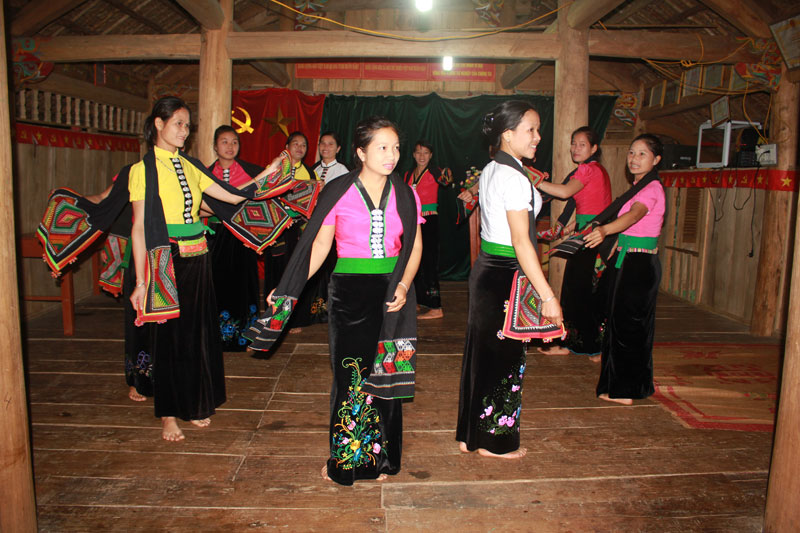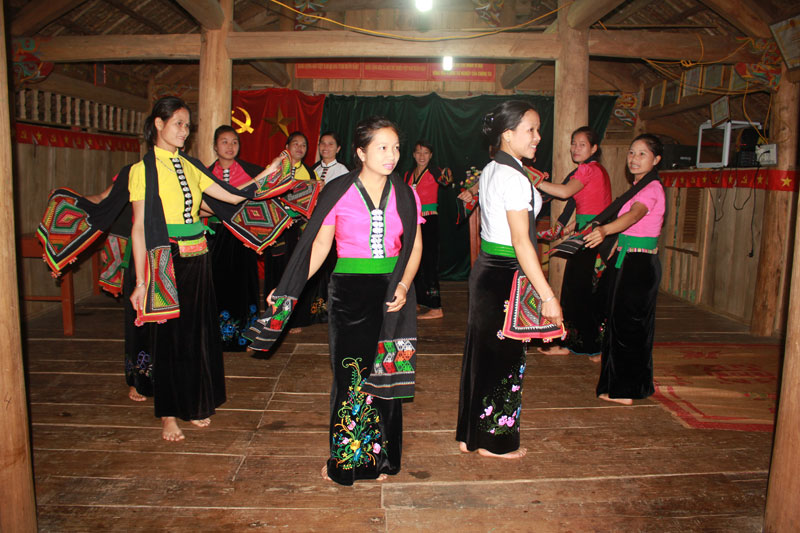
(HBO) - Tay ethnic people make up 40.57% of the 5 ethnic groups living together in Da Bac district. In the modern life rhythm, Tay ethnic culture of costumes, writing, customs and traditions are always preserved, especially the traditional costumes.

The performance team of Na Man hamlet, Muong Chieng commune (Da Bac) in traditional Tay ethnic costumes.
Men's costumes with shirts, pants, headscarves, sashes and especially the shaman's costumes also have their own beauty hidden in every detail. The men's shirts are usually long down to the waist, the neck stands about 3 cm high, cuts the chest and installs with a cloth button. The material made from self-woven cotton fabric, or black indigo with tight and narrow sleeves. In the past, men wore buttoned shirts on their shoulders and on the right flank, leaving their long hair tufts behind their necks. Today there is a little bit change with their chest skirts because the men often have the short hair. Accompanying the shirt is a wide and standing tube pants, made of white or indigo green cloth. When wearing, the waistband is tied in front of the belly and it is positioned with a cloth, called a sash with a natural color of divine flower or light pink. However, men often use sashes when going to festivals or in performing shows.
Women's costumes are more sophisticated with three types of shirts. They include short-sleeved shirts, short-sleeved tops with chestless buttons and long-sleeved shirts. They also use head scarfs, bibs, skirts and silk belts. The highlight of the dress is a tight-fitting short-sleeved shirt with a round collar and a chest split from the collar down to the skirt waistband. There is a pair of double silver butterflies or cicadas. There are odd pairs of buttons on short-sleeve like five pairs, seven pairs or nine pairs. The material is often thin fabric, sewn by the skillful hands of the Tay ethnic women. Coming along with a shirt is a bib. It is just like a pink or black short-sleeved with arnicas on the neck. The pure black dress or indigo blue consists of two types of embroidered skirt waistband and submerged flower skirt waistband. The Pieu scarf of all kinds of motifs shows the cultural characteristics, and also shows the skillful and delicate embroidery skills of the Tay ethnic women. Together with the outfit there are silk straps and jewelry such as necklaces, bracelets, earrings, gold or silver rings.
With an increasingly vibrant and widespread emulation movement aimed at building cultured residential areas and cultured families, Yen Thuy District has been making steady progress toward improving both the material and spiritual well-being of its people, while fostering a civilized, prosperous, beautiful, and progressive community.
Once lacking recreational spaces and community facilities, Residential Group 2 in Quynh Lam Ward (Hoa Binh City) has recently received attention for the construction of a new, spacious, and fully equipped cultural house. The project followed the model of state support combined with public contributions in both labor and funding.
The "All people unite to build cultural life" movement, which has been effectively integrated with Kim Boi district’s socio-economic development goals, is fostering a lively spirit of emulation across local residential areas, hamlets, villages, public agencies, and enterprises. In addition, through the initiative, traditional cultural values are being preserved and promoted, while community solidarity and mutual support in poverty reduction and economic development are being strengthened.
A working delegation of the Hoa Binh provincial People’s Committee led by its Permanent Vice Chairman Nguyen Van Toan on June 11 inspected the progress of a project to build the Mo Muong Cultural Heritage Conservation Space linked to tourism services in Hop Phong commune, Cao Phong district.
Born and growing in the heroic land of Muong Dong, Dinh Thi Kieu Dung, a resident in Bo town of Kim Boi district, in her childhood was nurtured by the sweet lullabies of her grandmother and mother. These melodies deeply imprinted on her soul, becoming an inseparable part of her love for her ethnic group's culture. For over 20 years, this love for her hometown has driven Dung to research, collect, and pass down the cultural values of the Muong people to future generations.
In the final days of May, the Ethnic Art Troupe of Hoa Binh Province organized performances to serve the people in remote, mountainous, and particularly disadvantaged areas within the province. These were not just ordinary artistic shows, but they were the meaningful journeys aimed at spreading cultural values, enhancing the spiritual life of the people and contributing to the preservation of ethnic minority cultural identities.



